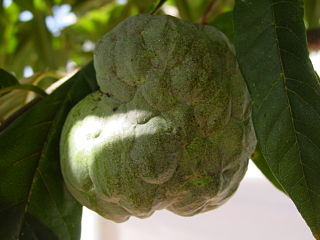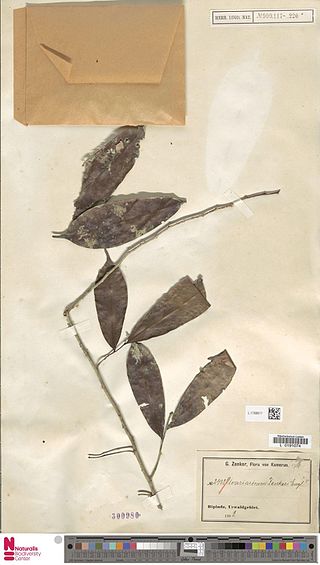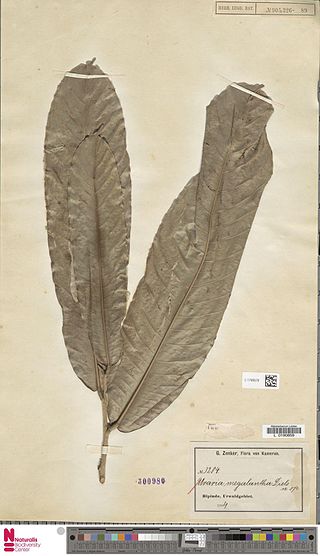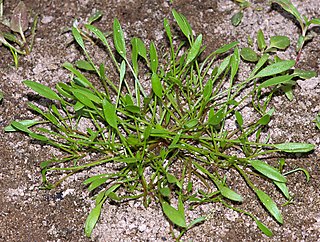
The Annonaceae are a family of flowering plants consisting of trees, shrubs, or rarely lianas commonly known as the custard apple family or soursop family. With 108 accepted genera and about 2400 known species, it is the largest family in the Magnoliales. Several genera produce edible fruit, most notably Annona, Anonidium, Asimina, Rollinia, and Uvaria. Its type genus is Annona. The family is concentrated in the tropics, with few species found in temperate regions. About 900 species are Neotropical, 450 are Afrotropical, and the remaining are Indomalayan.

Rollinia is a genus of plants in the family Annonaceae. While it is widely recognised as a distinct genus a monograph published in 2006 advocates its inclusion in Annona, which also contains custard apples and soursops.

Annickia is a genus of plant in family Annonaceae. Every species of this genus is native to continental Africa, from west Tropical Africa to Tanzania.

Guatteria is a genus of flowering plants in the family Annonaceae. It is the largest genus in the family in South America, and the dominant genus in mature forest. The fruits are berries, borne in clusters on short stalks.

Unonopsis is a genus of plant in family Annonaceae.
It contains the following species :

Uvariastrum is a genus of plants in the Annonaceae native to sub-Saharan Africa.

Uvariodendron is a genus of plants in the family Annonaceae. It contains the following species :

Xylopia is a genus of flowering plants in the family Annonaceae. They are mostly trees and some shrubs. There are about 160 species distributed in Asia, Africa, and the Americas.

Limosella is a genus of flowering plants known as mudworts. These are annual, largely aquatic plants, found in muddy areas worldwide. Its phylogeny and biogeography are inferred from molecular data.

Artabotrys is a genus of plants in the Annonaceae family. There are over 100 species in the Old World tropics, with 31 species in Africa. It is part of the custard apple family (Annonaceae). All species are small trees or shrubs with a tendency to climb. Leaves are simple and alternate, without hairs. Bisexual flowers are borne singly or in clusters opposite the leaves. The 6-petalled flowers are scented, and the plant bears fleshy fruits.

Duguetia is a genus of trees and shrubs in the plant family Annonaceae with approximately 90 species in central and South America, and four species in west Africa.

Cremastosperma is a genus of flowering plants in the family Annonaceae, subfamily Malmeoideae, tribe Malmeae. In 2018 there were 34 recognised species distributed in Central and South America.
Diclinanona is a genus of plants in the family Annonaceae.
Diclinanona calycina is a species of plant in the family Annonaceae. It is native to Brazil, Colombia, Peru and Venezuela. Ludwig Diels, the German botanist who first formally described the species using the basionym Xylopia calycina, named it after its well-developed calyx.

Pseudoxandra leiophylla is a species of plant in the family Annonaceae. It is native to Brazil, Colombia, and Venezuela. Ludwig Diels, the German botanist who first formally described the species using the basionym Unonopsis leiophylla, named it after its smooth leaves.

Pseudoxandra polyphleba is a species of plant in the family Annonaceae. It is native to Bolivia, Brazil, Colombia, French Guiana, Guyana, and Peru. Ludwig Diels, the German botanist who first formally described the species using the basionym Unonopsis polyphleba, named it after the distinctive veins in its leaves.

The Malmeoideae are a subfamily of trees and other plants of the family Annonaceae.

Annonoideae is a subfamily of plants in the family Annonaceae, with genera distributed in tropical areas world-wide. The family and this subfamily are based on the type genus Annona.

Desmopsis is a genus of flowering plants belonging to the family Annonaceae.
















